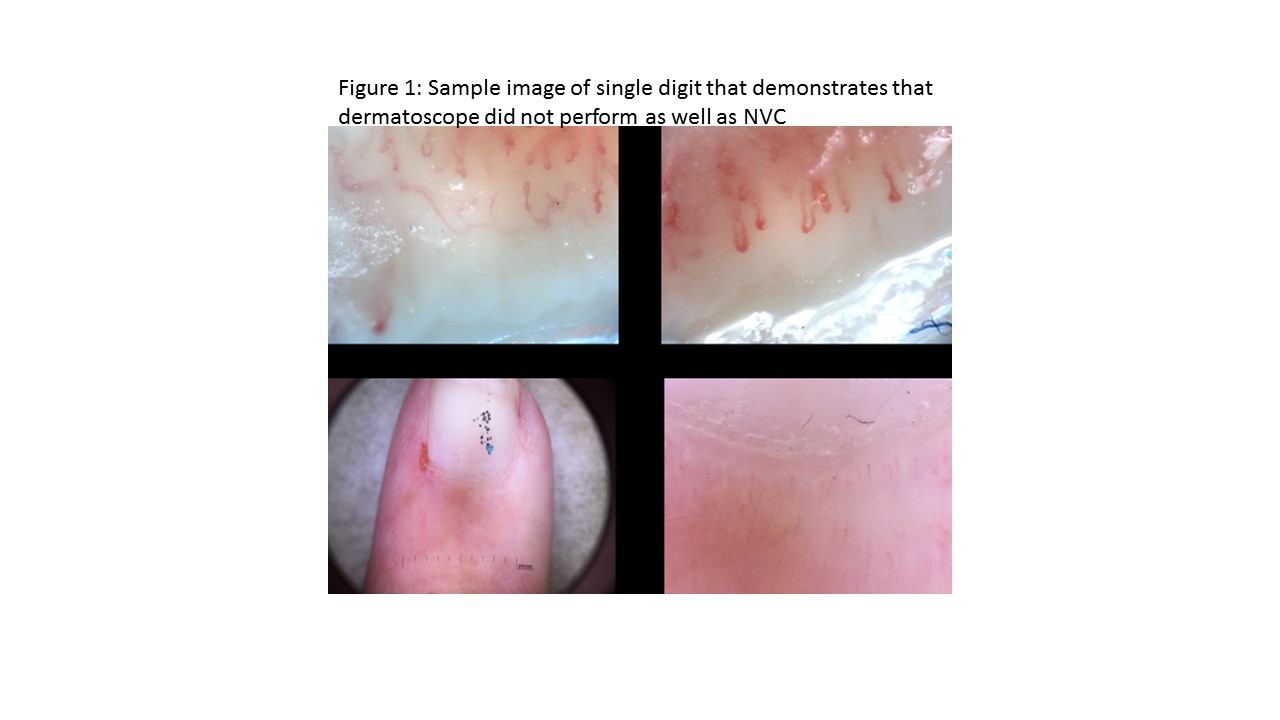Session Information
Session Type: ACR Poster Session C
Session Time: 9:00AM-11:00AM
Background/Purpose: The 2013 classification criteria for systemic sclerosis (SSc) provide 2 points (towards a 9 point diagnosis) for patients who have abnormal capillaroscopy. In the United States (U.S.), formal capillaroscopy training programs do not exist as part of fellowship training for assessment of patients complaining of Raynaud’s phenomenon. There is an effort in the European Union League Against Rheumatism (EULAR) microcirculation group to introduce training and certification for capillaroscopy in the United States (U.S.). The purpose of this project was to assess if U.S. trainees at a single center could effectively use nailfold videocapillaroscopy (NVC) with non-formal educational training provided by a local expert and through remote store-it-forward telehealth send images for additional teaching at other U.S. SSc centers. Additionally, the quality of dermatoscope images were compared to NVC to assess the role of this device for image capture.
Methods: Two trainees (JS and NL) had health related training in capillaroscopy, which involved observation and then hands-on performance of nailfold video capillaroscopy (NVC, Optilia®) and dermatoscope (Dermalite®) capillaroscopy on SSc registry patients. Subsequently 20 SSc patients had two NVC (Optilia®) and dermatoscope (Dermalite®) capillaroscopy on 8 digits obtained (Figure 1). These 153 images (2 patients had multiple auto-amputation) were interpreted by the two trainees and then sent to 2 U.S. members of the EULAR microcirculation group to determine whether normal versus abnormal could be effectively obtained and determined by dermatoscope, and whether trainees could identify abnormal features of NVC.
Results: The inter-rater reliability of the 153 NVC images was 0.82. Based on the NVC images all 20 patients would have been appropriately referred to a SSc center for further evaluation, but 29 images had additional abnormality features (micro-hemorrhage and neo-angiogenesis) found by the expert reviewers. Dermatoscope was able to recognize abnormal capillaroscopy in 13 of the 20 patients (65% of the time; Figure 1).
Conclusion: Store-it-forward capillaroscopy image capture with expert read is a potential modality to integrate nailfold capillaroscopy into U.S. fellowship training programs. While NVC is the gold-standard device for capillaroscopy, dermatoscope can be effectively used to evaluate the complaint of Raynaud’s phenomenon. This pilot suggests that nailfold capillaroscopy is an opportunity to integrate telehealth technology into rheumatology practice and educational curriculums. 
To cite this abstract in AMA style:
Stever JR, Lebedoff N, Frech TM, Saketkoo LA, Snow M. Nailfold Capillaroscopy Is an Opportunity for Telerheumatology [abstract]. Arthritis Rheumatol. 2017; 69 (suppl 10). https://acrabstracts.org/abstract/nailfold-capillaroscopy-is-an-opportunity-for-telerheumatology/. Accessed .« Back to 2017 ACR/ARHP Annual Meeting
ACR Meeting Abstracts - https://acrabstracts.org/abstract/nailfold-capillaroscopy-is-an-opportunity-for-telerheumatology/
